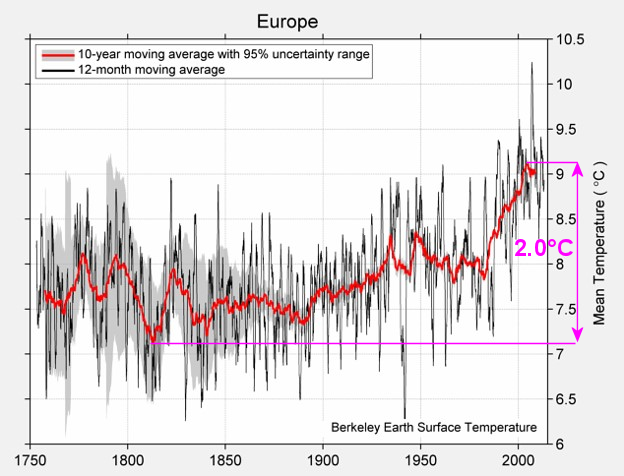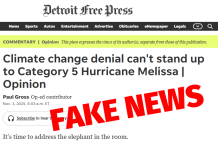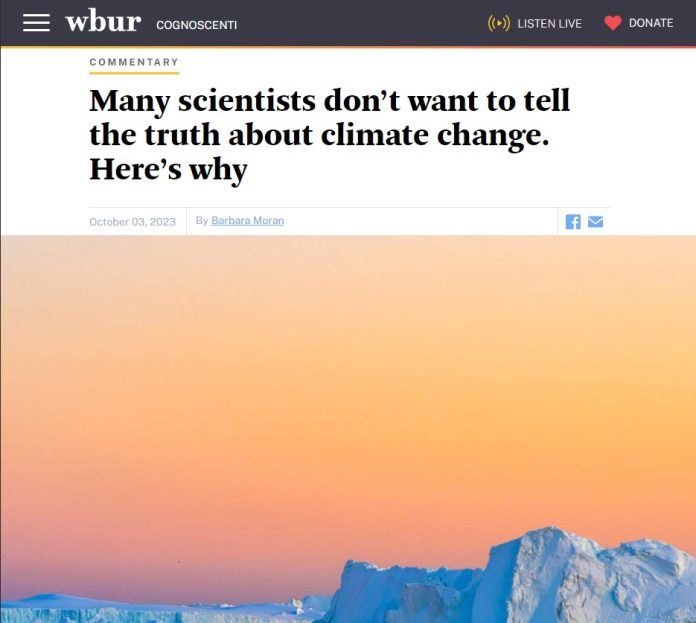An October 3, 2023 opinion piece by Barbara Moran at the WBUR (Boston) website has the headline “Many scientists don’t want to tell the truth about climate change. Here’s why.” Since human-caused climate change has become a topic of debate, climate scientists have routinely misstated facts and suppressed the truth.
The WBUR article centers, in particular, around the purported 1.5°C “warming limit” climate alarmists within the U.N. Intergovernmental Panel on Climate Change, and in the mainstream media and climate activist community have claimed since 2010 posed an amount of warming that would bring catastrophic, irreversible consequences. The first U.N. Framework Convention on Climate Change document to mention a limit to global warming of 1.5°C was the Cancun Agreement, adopted at the sixteenth COP (COP16) in 2010.
Now, in 2023, there’s a new worry. According to the WBUR article, “[i]n March, the United Nations released a massive climate change report. The biggest takeaway: Global warming will soon pass the oft-mentioned target of 1.5 degrees Celsius.”
Previously the big worry was that at 1.5 degrees, “tipping points” in the climate will occur. As Climate at a Glance: Tipping Points, shows there is no evidence that any such tipping points exist. Now the worry is that scientists might publicly admit the 1.5 degree Celsius rise is locked in, resulting people to giving up hope and ceasing to fight for scientists’ favored restrictions on fossil fuels.
The article says:
After this report came out, something weird happened. Unlike the blunt Dr. Thorne, most climate scientists (and journalists) didn’t change how they publicly spoke about 1.5 C. Admitting defeat could risk “demotivation” said Pascal Lamy, the commissioner of the Climate Overshoot Commission. Scientists kept saying things like: “We need to act now to stay below 1.5” or “it’s getting harder, but still technically possible.”
Climate scientists, in an effort to stave off despair, aren’t telling the truth about our warming planet. In reality, we’re incredibly close to the point of no return: when rising seas drown island nations and almost all coral reefs die. I’m here to tell climate scientists — and my fellow climate journalists — to knock it off.
Climate scientists lying about 1.5°C so we won’t lose hope? It seems that way. Yet there is no evidence thus far that passing 1.5°C means disaster. We’ve previously taken this topic to task on Climate Realism, here and here, and demonstrated, as seen in Figure 1. below, that in Europe, home of the longest surface temperature record, warming has already met and exceeded 1.5°C. In fact, a 2.0°C rise has been recorded.
 Figure 1. Berkeley Earth average European temperature since 1750. Source: https://berkeleyearth.lbl.gov/regions/europe
Figure 1. Berkeley Earth average European temperature since 1750. Source: https://berkeleyearth.lbl.gov/regions/europe
Despite a 2.0°C rise in temperature, Europe is still there. No disaster has occurred. No “tipping points” have happened. Yet climate scientists seem totally unaware of this fact, or simply choose to ignore it and not report it. Also, as showed repeatedly on Climate Realism, there is no evidence climate change is causing an increase in the negative impacts on coral reefs or small island nations that Moran is nattering on about.
Although the article didn’t consider this possibility, perhaps, the new worry is that when 1.5 degrees is surpassed and catastrophe does not occur, people will have even less faith in scientists’ alarming climate claims than polls show they already do.
If they lie about this 1.5°C limit being breached, what else are they hiding or lying about? If history is any indication, it seems almost everything.
As far back as 1989, climate scientists were already acknowledging they might have to suppress the truth and exaggerate the dangers of climate change to push climate action. In October 1989, the late Stephen Scheider, Ph.D., admitted to Discover Magazine:
On the one hand, as scientists we are ethically bound to the scientific method. On the other hand, we are not just scientists but human beings as well. To avert the risk [of potentially disastrous climate change] t we need to get some broad-based support, to capture the public’s imagination. That, of course, means getting loads of media coverage. So we have to offer up scary scenarios, make simplified, dramatic statements, and make little mention of any doubts we might have. Each of us has to decide what the right balance is between being effective and being honest.
And then there is the infamous “hockey stick graph” by Dr. Michael Mann, which has been shown to be nothing more than an artifact of splicing two dissimilar datasets together to hide the decline in tree-ring derived temperatures, aka “Mikes Nature Trick.”
During the ClimateGate scandal Dr Phil Jones wrote an email to Mann, which said:
“I can’t see either of these papers being in the next IPCC report. Kevin [Trenberth, a colleague] and I will keep them out somehow—even if we have to redefine what the peer-review literature is!”
Of course, James Hansen, Ph.D., former director of NASA’s Goddard Institute for Space Studies, predicted New York City’s West Side Highway would be underwater in 20 years from sea-level rise, and then when it didn’t come true claimed he really said 40 years.
Or, how about the claims of an ice-free Arctic due to climate change. Several claims were made by climate scientists, but none have come true.
In fact, there is an entire set of claims and predictions about climate from climate scientists that have never come true. As proof of this one can view a searchable plethora Failed Climate Predictions, here.
More recently climate scientist Patrick T. Brown, admitted to not telling the truth, the whole truth, and nothing but the truth about the causes of catastrophic wildfires in California. Brown reported in an article he wrote for the Free Press that a scientific paper he was the lead author of left out non-climate related factors which were significant factors driving the rapid growth in California wildfires in recent years. Brown wrote:
I just got published in Nature because I stuck to a narrative I knew the editors would like. That’s not the way science should work.
The paper I just published—“Climate warming increases extreme daily wildfire growth risk in California”—focuses exclusively on how climate change has affected extreme wildfire behavior. I knew not to try to quantify key aspects other than climate change in my research because it would dilute the story that prestigious journals like Nature and its rival, Science, want to tell.
This matters because it is critically important for scientists to be published in high-profile journals; in many ways, they are the gatekeepers for career success in academia. And the editors of these journals have made it abundantly clear, both by what they publish and what they reject, that they want climate papers that support certain preapproved narratives—even when those narratives come at the expense of broader knowledge for society.
To put it bluntly, climate science has become less about understanding the complexities of the world and more about serving as a kind of Cassandra, urgently warning the public about the dangers of climate change.
With these sorts of scientific shenanigans going on, lies of omission, and not owning up to failed predictions, is it any wonder that most citizens put climate change worry dead last on the list of concerns?
Science is supposed to be about finding and publishing the truth. Instead, it seems that climate science publishes what it believes is good for the so-called “sake of the planet” rather than scientific truth. For science to be useful, it must be held to a standard of truth, otherwise it becomes unbelievable and undermines the expansion of knowledge and progress. We all deserve better.
























So while Barbara Moran at WBUR is telling scientists and journos to tell the truth, she spreads lies in the process. Coral growth (and the GBR) are doing great with record growth being documented. New colonies are being found globally. We’ve already passed the 1.5 “tipping point” as pointed out by Mr. Watts. Why are they still perpetuating that lie? Moran used her column to spread disinformation while chiding people not to do the same.
The Earth is still in a 2.56 million-year ice age, in a cold interglacial period that alternates with very cold glacial periods. Outside of the tropics people have to wear warm clothes, use warm transportation, live in warm houses or apartments, and work in warm factories and office buildings during the winter and often during Spring and Autumn as well.
Total distortion of climate collapse is what makes this event even funnier than what the alarmists were hoping for with their conspiracy cockamamie predictions just to invoke fear and panic and probably garner a few more people into their cult of environmental wackoism!